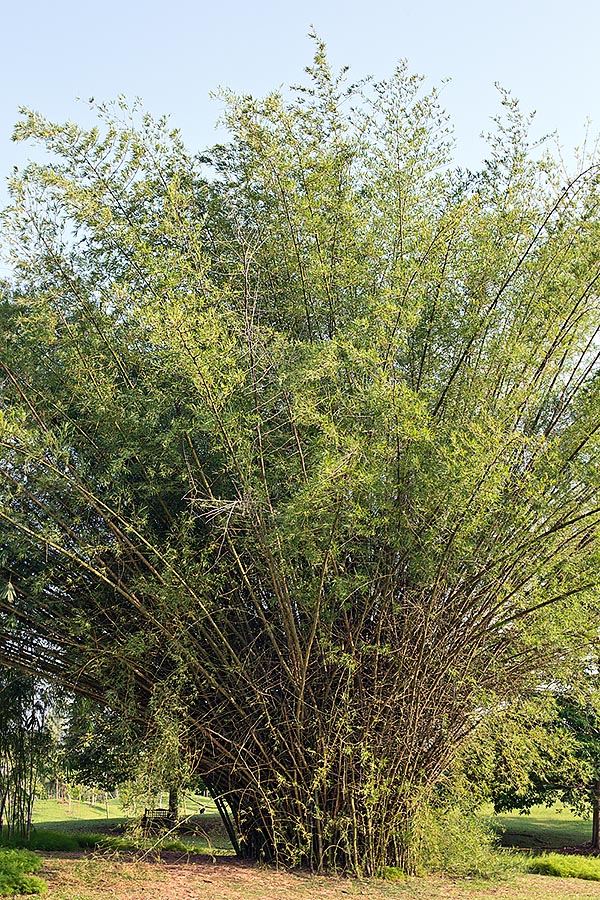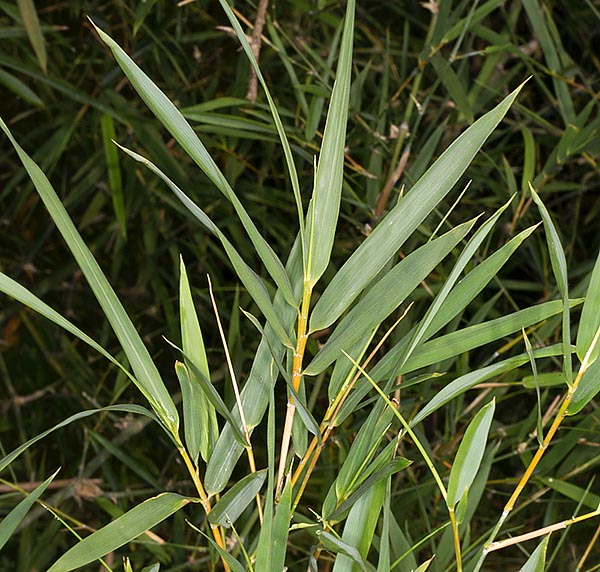Family : Poaceae

Text © Pietro Puccio

English translation by Mario Beltramini

Bambusa bambos reaches 30 m, with 15-18 cm stems and 20-40 cm internodes © Giuseppe Mazza
The name of the genus comes from the local Malaysian name “bamboo”; the name of the species from a local Indian name.
Common names: giant thorny bamboo, Indian thorny bamboo, spiny bamboo, thorny bamboo (English); banha, bnah, kata, koto, kotoha (Asamiya); baans, baansha, berua bans, behor, ketua, ketuasi (Bengali); bambou épineux, bambou roseau (French); bambu, buns, katabaans, katang, malabans, mangarabans (Hindi); raisai (Khmer); bambu-da-India, bambu-espinoso (Portuguese); mullumangila, mulmunkil, mungil (Tamil); phai-pa, phai-nam (Thai).
The Bambusa bambos (L.) Voss (1895) is a rhizomatous, imposing evergreen species, with robust cylindrical and close stems (culms), initially erect, then curved at the apex, up to about 30 m tall with a diameter of 15-18 cm or more in proximity to the base, and 20-40 cm long internodes of glossy intense green colour; the nodes are slightly prominent and the lowest ones have numerous aerial roots.
From each node originates a group of branches, of which a central one is predominant and 1-2 lateral ones are smaller, those of the lowest nodes are hard, thin, horizontal or bent downwards and provided with robust curved thorns, above they are arcuate, ramified and provided with leaves and small thorns. The leaves are alternate, linear to lanceolate with slightly pointed apex, 8-30 cm long and 1-2 cm broad.
While young, the culms are protected by deciduous triangular bracts, 15-30 cm long covered by dark brown hairs.
The inflorescences are great panicles with spikelets grouped at the nodes, 1,3-2,5 cm long; the fruit is a caryopsis (dried indehiscent fruit typical of the Poaceae) fusiform of pale brown colour, 6-8 mm long and of 1,5-2 mm of diameter.
The gregarious (which happens more or less at the same time in all the culms regardless of the age and the place) blooming, which entails the death of the plant, occurs in cycle varying between the 30 and the 50 years.

The leaves reach 30 cm. Edible buds, roots and seeds have medicinal virtues © Giuseppe Mazza
Fast-growing species cultivable in the tropical and humid subtropical climate zones and marginally in the temperate-warm ones, where temperatures just under the 0 °C are short-lasting exceptions; it requires full sun and rich soils, preferably acidic and constantly humid, but without stagnations, even if, well rooted, it can stand dry periods.
It is one of the most cultivated bamboos, especially in India, due to its manifold uses, in fact, it is employed in the buildings, for realizing furniture, handicrafts of various types and in the production of excellent quality paper, it is furthermore efficacious for stabilizing the soil and for realizing defence barriers, thanks to the presence of thorns.
The young shoots are edible and are consumed cooked with two changes of water or in brine and the leaves are utilized as fodder; leaves, roots and seeds are used in the traditional medicine for various pathologies.
Synonyms: Arundo bambos L. (1753); Arundo arborea Mill. (1768); Bambos arundinacea Retz. (1789); Bambusa arundinacea Retz. (1789); Arundo agrestis Lour. (1790); Bambos arundo J.F.Gmel. (1791); Arundo excelsa Salisb. (1796); Bambusa arundinacea Willd. (1799); Bambusa agrestis (Lour.) Poir. (1808); Bambos quinqueflora Stokes (1812); Bambusa spinosa Roxb. (1814); Nastus arundinaceus (Retz.) Sm. (1819); Bambusa spinosa Roxb. ex Buch.-Ham. (1822); Bambusa orientalis Nees (1835); Bambusa arundo Wight ex Steud. (1840); Arundo spinosa (Roxb. ex Buch.-Ham.) Oken (1841); Ischurochloa spinosa (Buch.-Ham.) Buse (1854); Ischurochloa arundinacea var. orientalis (Nees) Buse (1857); Bambusa neesiana Arn. ex Munro (1868); Arundarbor agrestis (Lour.) Kuntze (1891); Arundarbor arundinacea (Retz.) Kuntze (1891); Arundarbor bambos (L.) Kuntze (1891); Arundarbor orientalis (Nees) Kuntze (1891); Arundarbor spinosa (Buch.-Ham.) Kuntze (1891); Arundarbor teba (Miq.) Kuntze (1891); Bambusa bambusa Huth (1893); Bambusa arundinacea var. orientalis (Nees) Gamble (1896); Bambos bambos (L.) W.F.Wright (1905); Bambusa arundinacea var. spinosa (Buch.-Ham.) E.G.Camus (1913); Bambusa arundinacea var. gigantea (1981); Bambusa bambos var. spinosa (Buch.-Ham.) S.S.Jain & S.Biswas (2003).
→ To appreciate the biodiversity within the POACEAE family please click here.
